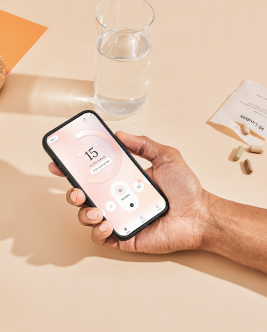science
Probiotic vs Prebiotic: What's the Difference, and Which is Right for You
On This Page

Probiotics and prebiotics seem like they’re everywhere these days — but what’s the difference between them and what do they actually do? We’re breaking it down.
Probiotics vs Prebiotics, the science made simple
Thanks in part to their science-backed gut health benefits, probiotics have become mainstays of buzzy health circles.
But what about prebiotics? Prebiotics are gaining attention as a complementary supplement to probiotics, and here we’ll break down the differences, similarities, and ways in which the two are complementary.
What are probiotics and prebiotics?
Here’s the long and short of it: Probiotics and prebiotics work together to create and maintain a healthy digestive system. Probiotics help balance and regulate the microbiome of your digestive system by colonizing your gut with beneficial bacteria. And prebiotics feed the good bacteria in your gut, keeping your digestive system happy and healthy. After all, a healthy gut is a happy gut. Let’s look a little closer at what they do:
Gut health support
Supporting gut health is the primary reason many people turn to probiotic and prebiotic supplements. Probiotics offer general support for gut balance and regularity. Meanwhile, prebiotics are nondigestible food ingredients that promote the growth and activity of the beneficial bacteria that probiotics provide. Think of prebiotics as probiotic fuel!
A key function of this thriving microbial community is to produce short-chain fatty acids in the colon. These compounds are essential because they can improve gut barrier integrity, metabolism, immune system function, and even support cardiovascular health.
Impact on digestive system
Probiotics and prebiotics have the potential to promote regular bowel movements. Since prebiotics are rich in fiber, they offer another layer of support to the digestive process. Their fiber content slows down carbohydrate digestion, ensuring a steady release of energy. This not only aids in maintaining healthy blood sugar levels (already in normal range), but also supports a balanced appetite, since fiber is known for promoting feelings of fullness.
While many experience the benefits of pre and probiotics, sensitive people may also experience temporary digestive discomfort, especially if they make sudden or drastic changes as the microbiome adjusts. It's always recommended to gradually introduce such foods or supplements to allow the digestive system time to adapt.
Influence on mental health
Did you know the gut is often referred to as our second brain? Well, this isn't just a saying – it's rooted in scientific truth! Our gut is intricately connected to our mental well-being. At the heart of this connection is the enteric nervous system, a vast network of neurons located in our gut. The enteric nervous system has been discovered to have strong links to both the central and peripheral nervous systems. This deep interconnection implies that the health of our gut can significantly impact our mood and mental state, and vice-versa.
Systematic reviews concluded that there is compelling evidence to suggest that probiotics support a healthy mood. This connection is believed to be tied to the gut-brain axis, where the microorganisms residing in our intestines communicate with our brain, influencing neural activity and mood regulation. While these findings are fascinating, there’s still a need for more, double-blind, randomized, and controlled trials on the subject before we can draw any final conclusions
So, what’s the difference between prebiotics and probiotics?
It’s clear that probiotics and prebiotics work together to promote optimal health benefits. Yet, they are completely different and have their own unique roles. Prebiotics are special types of fiber that act as food for gut bacteria, providing the nourishment they need to thrive. The term probiotic, on the other hand, refers broadly to the many types of beneficial microflora.
Probiotics explained
Let’s take a closer look at the myriad of benefits probiotics offer, their potential side effects, and where you can find them.
Benefits of probiotics
Probiotics help balance and regulate your gut microbiome by colonizing your gut with beneficial bacteria. Generally, our bodies are good at maintaining a healthy balance of “good” bacteria and non-beneficial bacteria. But sometimes, things like medications and other factors can create an imbalance. For example, an antibiotic is meant to wipe out specific non-beneficial bacteria in your system, but it also eliminates some good bacteria along the way.
When you’re experiencing an imbalance of bacteria in your gut microbiota and digestive tract, you can add more probiotics, like yogurt, to your diet, or take a probiotic supplement to help restore the balance of good bacteria in your body. Research has shown that probiotics can help promote gastrointestinal balance, aid in regulating bowel movements, and even counteract the digestive issues often linked to antibiotic usage, such as antibiotic associated diarrhea.
Beyond digestion, the influence of probiotics extends to the immune system, nourishing it and potentially bolstering our body's defense mechanisms. After all, a whopping 70% of your immune system lives in your intestines — so keeping this ecosystem balanced with “good” bacteria from probiotics is critical. Furthermore, probiotics play a role in supporting the intricate network of our enteric nervous system.
Potential side effects of probiotics
Probiotics are generally well-tolerated by most people, with side effects typically being mild, if any. The most common side effects include temporary gas and bloating. However, this is a normal occurrence that can happen when the body is adjusting to the new balance of beneficial bacteria in the gut.
But probiotics may not be suitable for everyone, especially those with compromised immune systems or certain health conditions. In addition, those with certain gastrointestinal conditions or sensitivities may find it harder to digest probiotic-rich foods, leading to digestive discomfort. Beyond that, some individuals with histamine/amine intolerances can experience some side effects with certain strains of probiotics.
Probiotics can also interact with a range of medications. Therefore, it's always recommended to consult with a doctor before incorporating probiotics into your regimen, ensuring that they don't adversely interact with any medications or underlying conditions you might have.
Foods rich in probiotics
Probiotics can be naturally found in fermented foods like kimchi, sauerkraut, kefir, tempeh, natto, or miso. Yogurt can also be an excellent probiotic source, but it’s vital to choose ones with live and active cultures. Unpasteurized pickles can also be a source of probiotics. However, most of the pickles on store shelves are not unpasteurized. Similarly, kombucha is a potential probiotic source, though not all commercially available versions maintain their probiotic properties. If you don’t eat many of these foods, you can always take a probiotic supplement.
Prebiotics explained
Now, let’s take a look at what we know about prebiotic benefits, their side effects, and the top food sources.
Benefits of prebiotics
Prebiotics serve as a food source for the good bacteria already there and do not contain any live bacteria. These special fibers enable gut bacteria to produce short-chain fatty acids (SCFAs) such as butyrate, lactic acid, and propionic acid. Without prebiotic support, the production of these vital SCFAs would be hindered. We need SCFAs, as they help to support microbiome diversity and immune system function.
Potential side effects of prebiotics
The side effects of prebiotics are largely attributed to the fiber they contain. Digestive symptoms such as gas, bloating, and temporary discomfort can emerge, especially if there’s a sudden spike in fiber intake without sufficient fluid consumption. Because of this, it’s important to balance higher-fiber meals and snacks with adequate hydration.
Additionally, like with many food-based substances, although rare, some individuals might have sensitivities or even allergies to certain prebiotic sources. Pay attention to how you feel before and after supplementing.
Foods rich in prebiotics
There are two primary sources of prebiotics: foods and supplements. Typically, prebiotic foods are high-fiber sources:
- Asparagus
- Dandelion greens
- Garlic
- Olives
- Leeks, onions
- Oats, barley
- Legumes/peas
- Flaxseeds
- Beans
- Almonds
- Banana
- Berries
- Jerusalem artichoke
- Seaweed
Should I take probiotic supplements?
Most people don’t eat fermented foods every day, and even if you do, it’s likely you’re consuming the same ones. We’re creatures of habit, after all. Clinical studies have shown that different strains of probiotics support gut flora in different ways. So, probiotic supplements offer an easy way to help restore good bacteria within our gut. Not all probiotics are created equal, though. It’s important to purchase your probiotic supplement from a reputable source that provides transparent labeling. Two probiotic formulations that may work well for you are a probiotic blend or a single-strain yeast probiotic. At Care/of, our probiotic blend combines three highly studied strains of bacteria (AKA probiotics): Bifidobacterium lactis (BB‑12), Lactobacillus rhamnosus GG, and Lactobacillus acidophilus (LA‑5) which have been shown to help colonize the gut with good bacteria.



